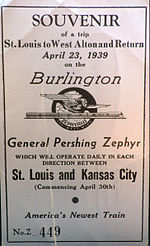General Pershing Zephyr
This articleneeds additional citations forverification.(November 2012) |

General Pershing Zephyr | ||||||||||||||||||||||||||||||||||||||||||||||||||||||||||||||||||||||||||||||||||||
|---|---|---|---|---|---|---|---|---|---|---|---|---|---|---|---|---|---|---|---|---|---|---|---|---|---|---|---|---|---|---|---|---|---|---|---|---|---|---|---|---|---|---|---|---|---|---|---|---|---|---|---|---|---|---|---|---|---|---|---|---|---|---|---|---|---|---|---|---|---|---|---|---|---|---|---|---|---|---|---|---|---|---|---|---|
| ||||||||||||||||||||||||||||||||||||||||||||||||||||||||||||||||||||||||||||||||||||
TheGeneral Pershing Zephyrwas the ninth of theChicago, Burlington & Quincy Railroad'sZephyrstreamliners,and the last built as an integrated streamliner rather than a train hauled by anEMD E-unitdiesel locomotive.It was constructed in 1939 with bodywork and passenger cars byBudd Companyanddiesel engine,electric transmission,powertruck,and other locomotive equipment byGeneral MotorsElectro-Motive Corporation.[1]Because its intendedKansas CitytoSt Louisroute passed near the birthplace and boyhood home of famousWorld War IGeneralJohn J. Pershing,the train was named after him. The power car was namedSilver Charger,after Pershing's horseCharger,while the passenger cars were named afterUnited States Armybadges of rank—Silver Leaf,Silver Eagle,andSilver Star.
The train replaced theOzark State Zephyr,which had been inaugurated three years earlier. In September, 1938, a second set was added, the 9903, which had previously served as theMark Twain Zephyrrunning betweenBurlington, Iowaand St Louis viaSamuel Clemens' birthplace ofHannibal, Missouri.TheOzark Stateservice inaugurated operating out of Kansas City in the morning and St Louis in the afternoon, with the second trainset alternating. The new equipment took over the original schedule, while the alternate timing was renamed theMark Twain Zephyr(despite not operating through Hannibal).
Unlike previousZephyrs,theGeneral Pershing Zephyrwas completely non-articulated; each car was self-contained and joined to the next bycouplers,rather than shared trucks. The inflexibility of the articulated layout had been recognised; it was hard to lengthen, shorten, or replace parts of the train. The route did not require a high-capacity train nor a powerful locomotive, so theGeneral Pershing Zephyrreturned to the pattern of the firstPioneer Zephyr,being a power/baggage car and three trailers. Budd also fitteddisc brakes,the first such practical installation to railroad passenger cars.[2]

The power car, 9908Silver Charger,was unique. It utilised a single newEMC 567V-12engine developing 1,000 hp, rather than the pair used in the contemporaryEMC E3.It had oneMartin Blomberg-designed E-unit A1A passenger truck at the front, with powered outer axles and a center idler axle, and an unpowered trailing truck, giving it the unusualwheel arrangementof A1A-2. This made it mechanically half of an E3. The back half of the power car was a baggage area. This made it similar to special power-baggage units built byEMDfor the Colorado Springs section of theChicago, Rock Island & Pacific RailroadRocky Mountain Rocket,though the latter had a carbody and E-3/E-6styling byEMD.The "Silver Charger" was the last power unit built by Budd with the unique "Zephyr" / "Flying Yankee" shovelnose styling. [3]It also carried sleeping cars. The train was number 32 when eastbound and number 33 when traveling west.[1]
The train ran its assigned route until the United States enteredWorld War II,during which time the trainset ran on many different routes. As 9908Silver Chargercould be detached from its trainset, it continued in service hauling other trains after the rest of the streamlined trainset was withdrawn. In this form it lasted in service until 1966, following which it was donated to theNational Museum of Transportationin St Louis.
Traveling between Kansas City and St Louis required theGeneral Pershing Zephyrto operate on tracks owned by theAlton Railroad,officially making them an operating partner. To symbolize this joint administration, theGeneral Pershing Zephyroften sported an "Alton Burlington" nose herald instead of the standard "Burlington Route" seen on most Burlington locomotives.
The diner-lounge-observation carSilver Starwas sold to Amax Iron Ore Corporation in 1974 for use on theMount Newman railwayinWestern Australiaand renamedSundowner.[4]It was used for many years as passenger accommodation on the fortnightly supply train to the mines. It was also used forVIPand inspection trains. Having last been used in 2003, it was sent toPerthfor rebuilding as the nucleus of theSilver Star CafeinPort Hedland.[5][6]
References
[edit]- ^ab"New Zephyrs Into Use".St. Joseph News-Press. 8 June 1939.Retrieved27 March2012.
- ^D.P. Morgan, "All About the RDC,"Trains & TravelMarch 1953
- ^Pinkpank, Jerry A (1973).The Second Diesel Spotter's Guide.Kalmbach Books. p. 106.LCCN66-22894.
- ^Touch of class for Mt NewmanRailway TransportationNovember 1974 pages 28, 30
- ^Quekett, Malcolm (October 26, 2010)."Historic carriage on track for third life".The West Australian.RetrievedMay 5,2012.
- ^The Silver StarRailway DigestOctober 2017 pages 42-45
Further reading
[edit]- Beebe, Lucius (1940).Highliners, A Railroad Album.New York: Bonanza Books.
- Joyce, John; Tilley, Allan (1979).Railways in the Pilbara.Wembley, Western Australia: J&A Publications. p. 88.ISBN0-9599699-2-6.
- Lotz, David.General Pershing Zephyr.Downloaded on December 24, 2004.
- Pinkepank, Jerry A. (1973).The Second Diesel Spotter's Guide.Kalmbach Publishing.ISBN0-89024-026-4.
- Webster, Mags (2010).The Silver Star: how a railroad icon made the journey from the American Midwest to the West Australian Pilbara(PDF).Perth, Western Australia: FORM. Archived fromthe original(PDF)on 2014-02-08.Retrieved2012-05-05.
External links
[edit]![]() Media related toGeneral Pershing Zephyrat Wikimedia Commons
Media related toGeneral Pershing Zephyrat Wikimedia Commons


